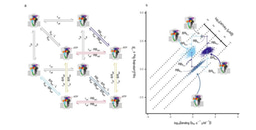Understanding Earth system interactions is key to sustainable food production
Published in Earth & Environment

The Planetary Boundaries (PBs) framework has lately emerged as one of the most influential and comprehensive ways to understand the safe limits of human activities on the Earth system. It has also been criticized – among other reasons – for its simplicity and even negligence of interactions between individual PBs. The story of this article was a classic “for future studies” remark coming true: we really should quantify the interactions between PBs. A recent review article provided the first quantitative estimates of some PB interactions, suggesting that the cascades and feedbacks of interactions amplify human impacts on the Earth system. But these interactions were still identified and quantified at the global scale while we wanted to understand those in more detail and smaller scales. In particular, we were after food production, which is a major cause of environmental change, leading to biodiversity loss, eutrophication, deforestation, freshwater systems’ degradation – and consequently exceedance of various planetary boundaries. It is possible that we have already pushed the Earth system beyond the safe operating space, risking abrupt or irreversible global environmental change. Hence, understanding how Earth system processes – represented by the PBs – interact at the local scales is crucial to remain within the safe operating space. In our work, we selected terrestrial and marine Earth system processes that are relevant to food production to elucidate unexplored or little-known interactions, which may restrain the safe operating space – or offer synergies for sustainability actions. If we knew these interactions and their magnitude better, we could better guide food system reforms, which will inevitably be required also due to the growing population and standards of living.
A study like ours had not been attempted before to this extent – though we heard from some co-authors that it had been discussed and discarded as “too difficult”. This is well imaginable, as in such a complex system, model-based quantification of the interactions is challenging, requiring computational tools currently out of reach. Further, biases within the PBs framework might hinder the effort – especially, the marine environment has received relatively little attention compared to its importance. And we agreed with all of this. If we are unable to learn more about Earth system interactions with existing models, then we should pool the experts of many fields together and listen to what they say about the interactions. We followed a structured expert elicitation protocol that minimizes bias of the elicited information and transforms experts’ qualitative knowledge into a quantitative format. The selected four Earth system processes were Biogeochemical flows, Biosphere integrity (BI), Freshwater use and Land system change. To better acknowledge the freshwater and marine environments, Biosphere integrity (BI) was divided into land, freshwater and ocean components. Further, ongoing work on revising the PB of Freshwater use prompted us to divide this process into Blue and Green water. Then, we determined a control variable and safe limits for each process, and laid our questions out to the experts. We asked them not only to evaluate the strength and associated uncertainty of interactions between any two control variables but also to think about the mechanisms involved – which proved invaluable in the end.
After two rounds of quantitative elicitation, a discussion round in between, and substantial double-checking and number crunching, we got what we had aimed for: the interaction strengths and mediating mechanisms. Out of a total 54 possible interactions, 37 were identified. This shows the highly interconnected nature of the selected control variables at the local scale. Many results were expected, as some interactions are well-known, such as the interactions between Land system change and BI Land. We could clearly distinguish processes that most prominently drive changes in others, especially Land system change and Green water – which is just about to be added in the PBs framework. Supporting the placement of Biosphere integrity as a core PB, we found strong interactions leading to changes in all BI components. Especially, the aquatic BI components were found to be strongly affected by changes in Blue water, Biogeochemical flows, and BI land. For instance, BI freshwater can be highly affected by increased nitrogen concentration in surface waters and decreased river discharge. On the opposite side, degrading BI Freshwater can substantially affect BI Land and BI ocean through trophic interactions between the three BI components. Zooming in at the local scale unveiled these – and many other – interactions that had gone unnoticed at the global scale. This also highlights the importance of all three BI components in future research. Our full network of interactions enables analyzing cascades and expected changes in many Earth system processes in case one is altered.
The network of mechanisms mediating the identified interactions turned out to be extremely complex. Not only are there primary, secondary, and context-specific mechanisms between the control variables, but also different mechanisms can even have counteracting effects on the resulting net interaction. The presence, importance, and potential local characteristics of different mechanisms determine the interaction strength and direction, which should be kept in mind instead of blindly using the aggregated interaction strengths in all contexts. The silver lining is that the mechanisms offer concrete action points to establish beneficial synergies. Though, not all interactions received equally extensive expert input. Based on the uncertainty evaluation, we suggest that priority should be given to interactions that we do not know so much about – but our results indicate they are strong. Such interactions could unexpectedly lead to breaching the safe operating space. When our work is to be continued, we should also explore interactions upon which the experts do not necessarily agree. Highlighting the case-specific nature of these interactions again, the expert discrepancies could be related to temporal scales, local contexts or the mechanisms involved.
An integrated approach to sustainable food production is imperative. Optimizing one Earth system process at the expense of others is not a viable option but improving many by actions on one is possible. Understanding their interactions and the mechanisms mediating them is key to governance that aims to keep us within the safe operating space – and provides enough food for everyone in the future. Our study is the first step towards a more comprehensive understanding of Earth system interactions at the local scale; it also demonstrates the power of expert elicitation in such complex study settings. We hope that our results will be broadly useful for sustainability management to avoid unintended consequences, finding synergistic solutions and directing management actions to the most important Earth system processes.

Follow the Topic
-
Nature Sustainability

This journal publishes significant original research from a broad range of natural, social and engineering fields about sustainability, its policy dimensions and possible solutions.




Please sign in or register for FREE
If you are a registered user on Research Communities by Springer Nature, please sign in